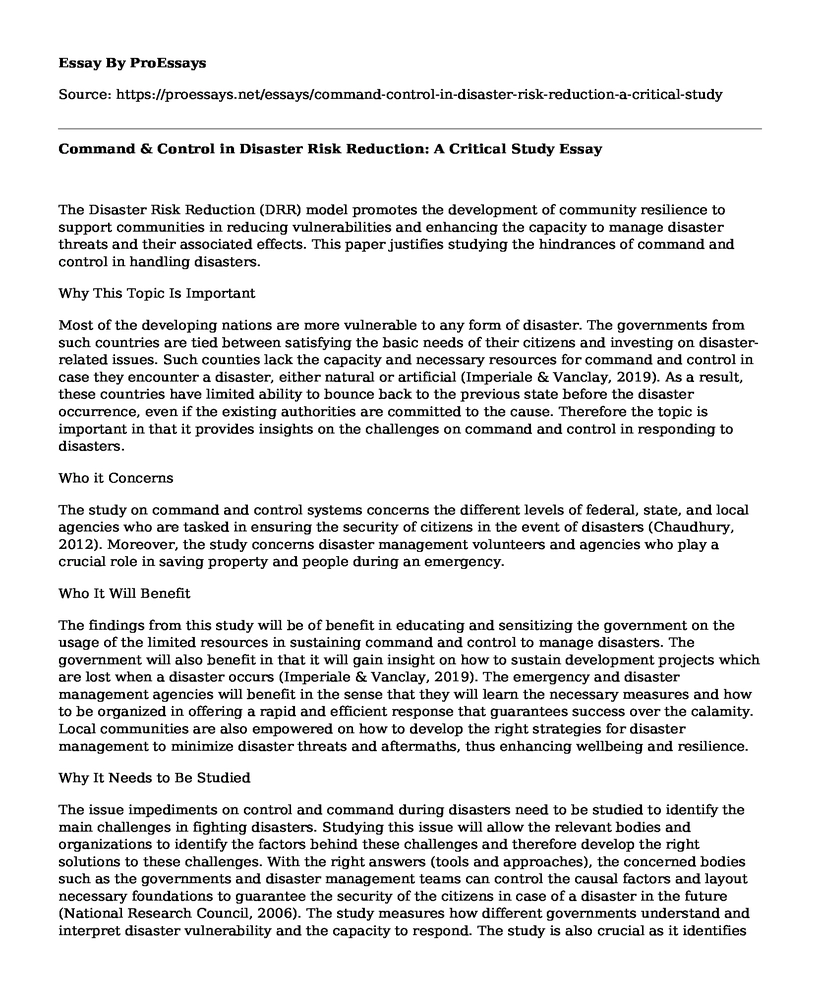The Disaster Risk Reduction (DRR) model promotes the development of community resilience to support communities in reducing vulnerabilities and enhancing the capacity to manage disaster threats and their associated effects. This paper justifies studying the hindrances of command and control in handling disasters.
Why This Topic Is Important
Most of the developing nations are more vulnerable to any form of disaster. The governments from such countries are tied between satisfying the basic needs of their citizens and investing on disaster-related issues. Such counties lack the capacity and necessary resources for command and control in case they encounter a disaster, either natural or artificial (Imperiale & Vanclay, 2019). As a result, these countries have limited ability to bounce back to the previous state before the disaster occurrence, even if the existing authorities are committed to the cause. Therefore the topic is important in that it provides insights on the challenges on command and control in responding to disasters.
Who it Concerns
The study on command and control systems concerns the different levels of federal, state, and local agencies who are tasked in ensuring the security of citizens in the event of disasters (Chaudhury, 2012). Moreover, the study concerns disaster management volunteers and agencies who play a crucial role in saving property and people during an emergency.
Who It Will Benefit
The findings from this study will be of benefit in educating and sensitizing the government on the usage of the limited resources in sustaining command and control to manage disasters. The government will also benefit in that it will gain insight on how to sustain development projects which are lost when a disaster occurs (Imperiale & Vanclay, 2019). The emergency and disaster management agencies will benefit in the sense that they will learn the necessary measures and how to be organized in offering a rapid and efficient response that guarantees success over the calamity. Local communities are also empowered on how to develop the right strategies for disaster management to minimize disaster threats and aftermaths, thus enhancing wellbeing and resilience.
Why It Needs to Be Studied
The issue impediments on control and command during disasters need to be studied to identify the main challenges in fighting disasters. Studying this issue will allow the relevant bodies and organizations to identify the factors behind these challenges and therefore develop the right solutions to these challenges. With the right answers (tools and approaches), the concerned bodies such as the governments and disaster management teams can control the causal factors and layout necessary foundations to guarantee the security of the citizens in case of a disaster in the future (National Research Council, 2006). The study measures how different governments understand and interpret disaster vulnerability and the capacity to respond. The study is also crucial as it identifies the role of governments in running coordination between various agencies as well as highlighting the role of the international community is stepping in and helping the country in crisis to manage the vulnerability.
Why this Work Should Occur Now
The relevance of this study is driven by the need to provide evidence-based and feasible solutions in responding to disasters to help navigate through disasters in the future.
Research Questions
What are the significant challenges and impediments of command and control in responding to disaster?
What are the factors that bring about these challenges?
What are the possible strategies to handle these challenges?
What are the resolutions to overcome these impediments?
References
Imperiale, A. J., & Vanclay, F. (2019). Command-and-control, emergency powers, and the failure to observe United Nations disaster management principles following the 2009 L'Aquila earthquake. International journal of disaster risk reduction, 36, 101099.
National Research Council. (2006). Facing Hazards and disasters: Understanding human dimensions. National Academies Press.
Chaudhury, K. S., Nibedita, A., & Mishra, P. K. (2012). Command And Control in Disaster Management. International Journal of Computer Science Issues (IJCSI), 9(4), 256.
Cite this page
Command & Control in Disaster Risk Reduction: A Critical Study. (2023, May 30). Retrieved from https://proessays.net/essays/command-control-in-disaster-risk-reduction-a-critical-study
If you are the original author of this essay and no longer wish to have it published on the ProEssays website, please click below to request its removal:
- Animal Farm Literary Analysis Example
- Stress Hormones Negative Impacts on the Respiratory and the Cardiovascular Systems
- "The Ocean at the End of the Lane" by Neil Gaiman Essay
- Literary Analysis Essay on Gain and Loss in 'Paradise Lost' by John Milton
- Functional Conflict and Dysfunctional Conflict Essay Example
- Essay Sample on Nursing Education
- Paper Example on Feminist Poetry: A Movement of Self-Realization & Social Awareness







